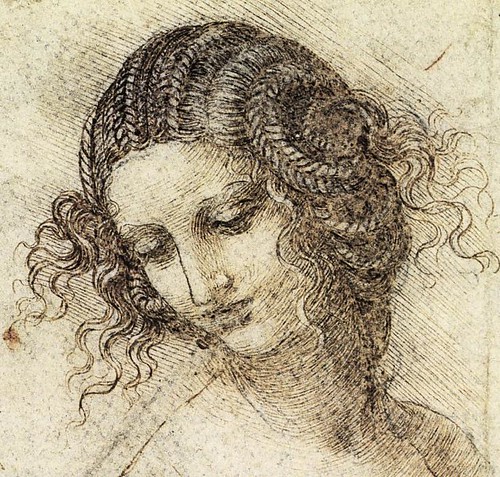❝ Study for the Head of Leda, Credited to Leonardo Da Vinci, c. 1505-7
The image above is a silverpoint drawing of Leda. Credited to Leonardo Da Vinci between 1505 to 1507. [0] I remember looking at the originals on loan from the London Museum in Melbourne at the NGV (National Gallery of Victoria). Drawn with a silverpoint pen on paper coated with crushed bone (Vellum) [1] to create a rough surface. It was dark as direct light would impact on the drawings.
I remember looking at the centre image very closely. Leonardo discovered things that are still being re-discovered today. I'm thinking in particular turbulent efficient valves for hearts
Reply to Dabblers and Blowhards
The comments below, first appeared on HackerNews in 2008 in reply to an article, Dabblers and Blowhards.
"I've always felt the painters connection was too tightly focused, though I think this essay (which is ancient, and would either be more true of pg's work today or less depending on how much you agree with it) goes overboard and manages to miss the point"
I don't think the hacker/painter correlation is far off the mark. We might not know of many painters who can hack but I think the idea might better be illustrated by someone who could be best described as a "Hacker" in his day, Leonardo.
Leonardo had lots of attributes you could ascribe to modern day Hackers:
Leonardo was inately curious. For example, how else would you work out how the human heart valves worked or the observation that the hardening and constriction of the minute capillaries in old people, compared to young babies, has something to do with death. Something that modern science had to re—discover.
Leonardo wrote excessively in notebook diaries on ideas and creations he was working on. I've seen a sample of these diaries as part of the Royal Library collection. Images of cross sections from human skulls to yet to be born in-eutero.
Leonardo sketched out his ideas as a combination of pictures and words using silverpoint on vellum, a prepared animal hide covered with ground up animal bones and glue. then built upon these prior ideas as finished works.
Leonardo, emperical in outlook and willing to try new ideas. He observed what worked and not just theorised or accepted common wisdom. A good example of this can be found in the paint composition of "The Last Supper". Leonardo decided "fresco" didn't allow him to express his painterly style, shunned the conventional and trie "fresco" over "gesso" (gypsum). In this case it failed miserably. But this ability to experiment also allowed Leonardo to master oils. The results of this stable medium you can see today in "La Gioconda" in the Louvre in Paris.
Leonardo exhibited unnatural powers of concentration, shunning food, rest and drink for instance during the painting of "The Last Supper".)
Leonardo attaind mastery of many different technologies
The key bit that most people might not realise is that for Leonardo, painting was his technological multiplier. Leonardo expressed his sketches as drawings and words and presented finished ideas in paint. It is through the act of painting that we recognise the most famous painting of the Renaissance. I think the key to understanding the relationship between hackers and painters is that the expression of the intangible thought through art is what matters.
Painting and drawing of ideas is to Leonardo as Macs are to modern day hackers. The product might be different but in the end both, modern Hacker and Leonardo as painter create new, seemingly intangible things from pure thought. I'm not surprised pg went to study in Florence. What does surprise me is why it took so long to realise that it was not the location that elevated Leonardo but the "tech revolution" of the time, painting.
Reference
[0] Leonardo da Vinci, "The drawings of Leonardo da Vinci. Study for the Head of Leda, c. 1505-7"
http://www.drawingsofleonardo.org/images/leda.jpg
[Last Accessed Friday 16th December, 2016]
[1] Vellum, Wikipedia, "An animal skin, usually calf, prepared by cleaning, stretching and scraping. Tension is created by drying and wetting. The final surface is covered with a ground bonemeal (finely ground up animal bones) mixture which gives the surface a rough texture suitable for silverpoint."
I remember toying with the idea of creating some vellum and trying Silverpoint. The masters used techniques that allowed their works to survive hundreds of years.
https://en.wikipedia.org/wiki/Vellum
[Last Accessed Friday 16th December, 2016]

